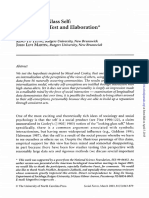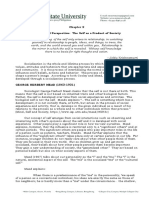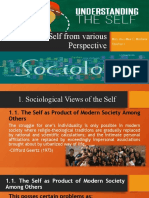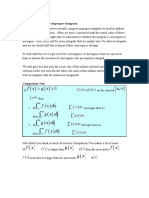The Looking-Glass Self
The Looking-Glass Self
Uploaded by
Kharl CastilloCopyright:
Available Formats
The Looking-Glass Self
The Looking-Glass Self
Uploaded by
Kharl CastilloOriginal Title
Copyright
Available Formats
Share this document
Did you find this document useful?
Is this content inappropriate?
Copyright:
Available Formats
The Looking-Glass Self
The Looking-Glass Self
Uploaded by
Kharl CastilloCopyright:
Available Formats
The looking-glass self was first introduced by Charles Cooley (1902).
People may have a self-image
that is formed by their interactions with others, or even no self at all. Cooley argued that the dynamic
of self-creation is similar to a mirror. One's perceptions of others' judgments can be highly inaccurate.
While individuals' self-image are shaped by others, this only happens through the mediation of their
minds. People use the looking-glass self to control and evaluate the responses of others (Squirrell,
2020).
In the early 1900s, Thomas Cooley argued that the self-creation dynamic is similar to that of a mirror.
In imagination we perceive in another's mind some thought of our appearance, manner, aims, deeds,
character, friends, and so on, and are variously affected by it.
People's self-image is shaped by others, but this only happens through the mediation of their own
minds. One's perceptions of others' judgments can be highly inaccurate - for example, on a dance
floor, many people who see themselves as "good" dancers may be perceived as "bad" dancers, but
will nonetheless react as if they are good dancers.
The eye-gouging effect refers to the individual's selective application of looking-glass self - i.e. the way
they filter their self out among a large group of people.
To summarize, the relationship and alignment between the perceived and actual responses of others
is heavily dependent on context, and people generally select whose responses do and do not matter
to them.
According to Cooley, people learn to use the “looking-glass” — and thus learn who the self is —
through primary groups such as the family. Primary groups are “characterized by intimate face-to-face
association and cooperation (McIntyre, 1998).
They are primary in several senses but chiefly in that they are fundamental in forming the social
nature and ideals of individuals. The result of intimate association, psychologically, is a certain fusion
of individualities in a common whole, so that one’s very self, for many purposes at least, is the
common life and purpose of the group” (Cooley, 1998).
That is to say that Cooley believed that primary groups were strong agents of socialization and that in
primary groups, people learn to read what others are thinking and to discover what happens when
they adjust their behavior according to what they are thinking (McIntyre, 1998).
However, there remain two main controversies in how sociologists investigate self-image that the
looking-glass self addresses (Squirrell, 2020):
1. To what extent is the self-image shaped by society and circumstances, and to what extent is
the self a reflection of one’s essential qualities?
2. What frameworks can be used to understand how the environment shapes the self?
You might also like
- Charles Horton Cooley PDFDocument5 pagesCharles Horton Cooley PDFArXlan Xahir83% (6)
- 900+ Best ChatGPT PromptsDocument73 pages900+ Best ChatGPT PromptsAhmad Dawami50% (6)
- UTS George Kelly Personal Construct TheoryDocument14 pagesUTS George Kelly Personal Construct TheoryKoleen Lopez ÜNo ratings yet
- I and Me TheoryDocument30 pagesI and Me TheoryAnariza S. GermoNo ratings yet
- Charles CooleyDocument2 pagesCharles CooleyKharl CastilloNo ratings yet
- Looking-Glass Self Theory Definition Amp ExamplesDocument11 pagesLooking-Glass Self Theory Definition Amp Examplesphuong linhNo ratings yet
- Note Highligths The Important Only F Not Close Parenthises Thats Explain (Ucsp)Document13 pagesNote Highligths The Important Only F Not Close Parenthises Thats Explain (Ucsp)Coleen Jhoy SieteNo ratings yet
- C. Cooley - S Looking Glass Self TheoryDocument2 pagesC. Cooley - S Looking Glass Self Theorydevtiwari2003No ratings yet
- Charles Horton CooleyDocument1 pageCharles Horton CooleyzainabNo ratings yet
- Reading Mat For 2nd ExamDocument33 pagesReading Mat For 2nd Examf.mantica.127363.tcNo ratings yet
- Charles Cooley WikipediaDocument4 pagesCharles Cooley WikipediaFariz HadyanNo ratings yet
- Looking GlassDocument12 pagesLooking GlassGlenn Cacho GarceNo ratings yet
- Lesson 2 Sociological Self PrintDocument3 pagesLesson 2 Sociological Self PrintGrace MendezNo ratings yet
- The Looking Glass SeIf - An Empirical Test and ElaborationDocument37 pagesThe Looking Glass SeIf - An Empirical Test and ElaborationAndreeaNo ratings yet
- National Law Institute University, BhopalDocument14 pagesNational Law Institute University, BhopalAnay MehrotraNo ratings yet
- The Looking Glass LensDocument26 pagesThe Looking Glass LensAndreeaNo ratings yet
- C H CooleyDocument44 pagesC H CooleySalima HabeebNo ratings yet
- CooleyDocument8 pagesCooleykonerudeepika206No ratings yet
- 81 Soc F843Document39 pages81 Soc F843bhargavimulmuleyNo ratings yet
- charlescooley-211211152656Document18 pagescharlescooley-211211152656Angelica BananiaNo ratings yet
- Written Report in UTSDocument5 pagesWritten Report in UTSClaire Awa-aoNo ratings yet
- Lesson 2 UTSDocument17 pagesLesson 2 UTSgirlmatampacNo ratings yet
- H3 - The Mirror Self by Charles CooleyDocument2 pagesH3 - The Mirror Self by Charles CooleymmstalaveraNo ratings yet
- Chapter I: The Self From Various Perspective: B. SociologyDocument13 pagesChapter I: The Self From Various Perspective: B. SociologyCherry Mae CabuangNo ratings yet
- Understanding-The-Self-Ge-1 ReportDocument5 pagesUnderstanding-The-Self-Ge-1 Reportsualog.markanthony28No ratings yet
- Outline: Understanding The "Self"Document4 pagesOutline: Understanding The "Self"blogs414No ratings yet
- Thinking SociologicallyDocument5 pagesThinking Sociologicallypriyanshu.g4804No ratings yet
- GE1 Week 7 ModuleDocument9 pagesGE1 Week 7 ModuleCharm Angel LopezNo ratings yet
- Theories of SocialisationDocument8 pagesTheories of SocialisationBobby S. MathewNo ratings yet
- Ge 1 UtsDocument41 pagesGe 1 UtsmargaducusinNo ratings yet
- Chapter 2 - Sociological Perspective: The Self As A Product of SocietyDocument2 pagesChapter 2 - Sociological Perspective: The Self As A Product of SocietyAsuna YuukiNo ratings yet
- INTRODUCTION TO KELLY PsychologyDocument6 pagesINTRODUCTION TO KELLY PsychologyannanjacobjameszNo ratings yet
- Lesson 3-Notes and Activity-SociologicalDocument8 pagesLesson 3-Notes and Activity-SociologicalEL-JHEAN TA�OLANo ratings yet
- Understanding The Self - Module 2Document7 pagesUnderstanding The Self - Module 2Jaja CabanillaNo ratings yet
- Social Self Role of Social SituationDocument25 pagesSocial Self Role of Social SituationCHRISTINE JULIANENo ratings yet
- STFP Charles Horton CooleyDocument12 pagesSTFP Charles Horton CooleyOniwosàn Tani JóNo ratings yet
- Chapter 2 Sociological Perspective The Self As A Product of SocietyDocument4 pagesChapter 2 Sociological Perspective The Self As A Product of SocietySAMARITA, SHAINA MARIE J.100% (1)
- SociobypearlDocument30 pagesSociobypearlgray ronan100% (3)
- UTS - The Sociological PerspectiveDocument17 pagesUTS - The Sociological PerspectivesaismarupokNo ratings yet
- Module 2Document9 pagesModule 2Princess Angie GonzalesNo ratings yet
- Sociological Perspective of The Self (Bsce)Document8 pagesSociological Perspective of The Self (Bsce)Luis Mario Guillermo100% (2)
- Preparatory Stage (Birth - 3 Years Old) Play Stage (3 Years Old - 5 Years Old) - Game Stage (6 Years Old - 9 Years Old)Document2 pagesPreparatory Stage (Birth - 3 Years Old) Play Stage (3 Years Old - 5 Years Old) - Game Stage (6 Years Old - 9 Years Old)Rainer DeezNo ratings yet
- Uts Mod 2Document13 pagesUts Mod 2Stephanie DacumaNo ratings yet
- Theories of SocializationDocument2 pagesTheories of Socializationsolisjesse85No ratings yet
- Topic 4 Sociological Perspective of The SelfDocument4 pagesTopic 4 Sociological Perspective of The Selfdavegubalane11No ratings yet
- GUS Prelim Unit4Document3 pagesGUS Prelim Unit4Bea Marielle MendozaNo ratings yet
- Sociology The Self From Various PerspectiveDocument21 pagesSociology The Self From Various PerspectiveJoevinz MasbateNo ratings yet
- Understanding The Self Lesson 5Document5 pagesUnderstanding The Self Lesson 5Kherwin ValenciaNo ratings yet
- Module 2 Sociological PerspectiveDocument7 pagesModule 2 Sociological PerspectiveKaye CarbonelNo ratings yet
- Sample 2Document2 pagesSample 2Unknown xYzNo ratings yet
- Week13 Comparingperceptionsofonesselfandhowothersseethem 230815120921 42f41843Document29 pagesWeek13 Comparingperceptionsofonesselfandhowothersseethem 230815120921 42f41843parkklerlinNo ratings yet
- PS 1-Pending NotesDocument6 pagesPS 1-Pending NotesnarayanisreesNo ratings yet
- LESSON 2 Sociological Perspective of The SelfDocument5 pagesLESSON 2 Sociological Perspective of The SelfMary Joy CornelioNo ratings yet
- Self Module 02 PDFDocument5 pagesSelf Module 02 PDFMalaluan, Njel Shane L.No ratings yet
- 03 (Presentation) Sociological Perspectives (Sir Eugenio)Document22 pages03 (Presentation) Sociological Perspectives (Sir Eugenio)ROLAND ROBLESNo ratings yet
- The Looking Glass Self Theory: Keanne Angulo Bsn-Stem 1Document1 pageThe Looking Glass Self Theory: Keanne Angulo Bsn-Stem 1Sphyre RosetteNo ratings yet
- Looking-Glass Self - WikipediaDocument24 pagesLooking-Glass Self - Wikipediashahzaadahmed191No ratings yet
- Looking-Glass SelfDocument5 pagesLooking-Glass Selfdanielles.bonillaNo ratings yet
- Understanding The Self: Self From Various Perspectives (Sociology)Document26 pagesUnderstanding The Self: Self From Various Perspectives (Sociology)nan nanNo ratings yet
- Lesson 2:: Sociological Perspectives of The SelfDocument4 pagesLesson 2:: Sociological Perspectives of The SelfCarlo AganNo ratings yet
- Purposive Commu Wps OfficeDocument5 pagesPurposive Commu Wps OfficeKharl CastilloNo ratings yet
- Lesson 2-Developing A Business PlanDocument34 pagesLesson 2-Developing A Business PlanKharl CastilloNo ratings yet
- CurriculumDocument1 pageCurriculumKharl CastilloNo ratings yet
- Cavite MutinyDocument1 pageCavite MutinyKharl CastilloNo ratings yet
- Foundation of Inclusion and Special EducationDocument1 pageFoundation of Inclusion and Special EducationKharl CastilloNo ratings yet
- Nfpa13 4Document1 pageNfpa13 4Ljubisa Kurcubic KureNo ratings yet
- Problema 5.34 TaylorDocument7 pagesProblema 5.34 Taylorcerobr15No ratings yet
- Full Download Automation in Garment Manufacturing 1st Edition Rajkishore Nayak PDFDocument53 pagesFull Download Automation in Garment Manufacturing 1st Edition Rajkishore Nayak PDFgerylthadee100% (2)
- User Manual: Macherey-NagelDocument34 pagesUser Manual: Macherey-NagelBatuli MwaijandeNo ratings yet
- Lab Report No 2 (M Saad Javed)Document5 pagesLab Report No 2 (M Saad Javed)SAAD JAVEDNo ratings yet
- WorkflowSim-A Toolkit For Simulating Scientific Workflows in Distibuted EnvironmentsDocument26 pagesWorkflowSim-A Toolkit For Simulating Scientific Workflows in Distibuted EnvironmentsSanthosh B AcharyaNo ratings yet
- A3 Poster - Template - Industry ConclaveDocument1 pageA3 Poster - Template - Industry ConclaveGopinathNo ratings yet
- Chapter 2 PCK 105 ReportDocument25 pagesChapter 2 PCK 105 ReportBhebot Mendiola AnisNo ratings yet
- Untitled 1Document11 pagesUntitled 1Abby KakimbaNo ratings yet
- Escape at Dunkirk InfographicDocument2 pagesEscape at Dunkirk InfographicMaya JasNo ratings yet
- R Data Analysis Cookbook - Sample ChapterDocument29 pagesR Data Analysis Cookbook - Sample ChapterPackt PublishingNo ratings yet
- Color RefinementDocument22 pagesColor RefinementDino BENITO MONZONo ratings yet
- Nurs FPX 4010 Assessment 3 Interdisciplinary Plan ProposalDocument5 pagesNurs FPX 4010 Assessment 3 Interdisciplinary Plan Proposallilykevin075No ratings yet
- Dermatitis Kontak: DR Putra Hendra SPPD UnibaDocument44 pagesDermatitis Kontak: DR Putra Hendra SPPD UnibaSyahrialNo ratings yet
- An Honest Woodsman and His AxeDocument1 pageAn Honest Woodsman and His AxeRizqa Gusti NarawitaNo ratings yet
- Comparison Test For Improper IntegralsDocument8 pagesComparison Test For Improper IntegralsKRAZA2092No ratings yet
- Strategic Implementation ASSIGNMENTDocument7 pagesStrategic Implementation ASSIGNMENTjeyaprakashaaryanNo ratings yet
- Minrom Training BrochureDocument3 pagesMinrom Training BrochureSaronga JuliusNo ratings yet
- French Chocolate TruffleDocument4 pagesFrench Chocolate TrufflePetreNo ratings yet
- Test Paper If ClausesDocument4 pagesTest Paper If ClausesMIHAELA-ELENA ZAMFIRNo ratings yet
- Final QuesDocument5 pagesFinal QuesMani KumarNo ratings yet
- Acute Respiratory Distress Syndrome - PathophysiologyDocument5 pagesAcute Respiratory Distress Syndrome - PathophysiologyJoann75% (4)
- Pa2 Syllabus 24 IxDocument2 pagesPa2 Syllabus 24 Ixdhyanmehta45No ratings yet
- Remaining A: in AsiaDocument12 pagesRemaining A: in AsiaakrkNo ratings yet
- From The Laboratory To The Field: Successful Multistage Horizontal Fracturing Design and Implementation in Tight Sandstones in The Anadarko BasinDocument25 pagesFrom The Laboratory To The Field: Successful Multistage Horizontal Fracturing Design and Implementation in Tight Sandstones in The Anadarko BasinErdal AYDINNo ratings yet
- Production of ImsDocument32 pagesProduction of ImsMAY ANN DE VERANo ratings yet
- Book Review of Design: Creation of Artifacts in Society by Karl T. UlrichDocument22 pagesBook Review of Design: Creation of Artifacts in Society by Karl T. UlrichSrujan BabuNo ratings yet
- MPX2053 MPXV2053G DatasheetDocument12 pagesMPX2053 MPXV2053G DatasheetkurmakkNo ratings yet
- Test 1: Gerunds and Infinitives / Test 1 (42 Adet Soru) Eskişehir YesdđlDocument4 pagesTest 1: Gerunds and Infinitives / Test 1 (42 Adet Soru) Eskişehir YesdđlTayanc Andy AkgünNo ratings yet






























































































